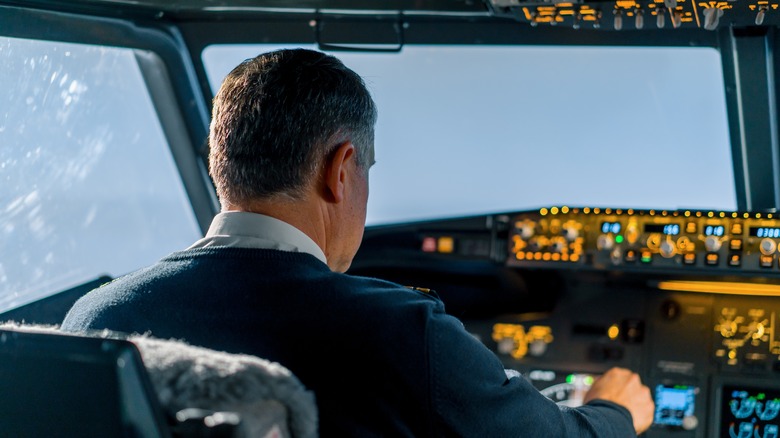Unsettling TikTok Shows What Turbulence Really Looks Like From A Pilot's Perspective
The feeling of being jostled and shaken during a period of turbulence on a flight is not unusual. It is a typical part of traveling that most people expect, but very few enjoy. Many travelers find ways to cope with turbulence so that it doesn't increase their anxiety about flying or interfere with their journey. Yet it's hard to know exactly what conditions are taking place to cause this type of disturbance during a flight. Have you ever wondered what it looks like from the pilot's point of view when an aircraft begins to experience turbulence? A popular TikTok has now answered this question. The video shares a scene from inside the cockpit of a plane as the aircraft begins to experience these rough conditions, and the comments reflect people's astonishment about what's really happening.
The TikTok is made by Unilad, the British media firm that specializes in providing unique content to its 3.4 million followers. The video sets the scene of a pilot behind the controls of an aircraft with a body of clouds visible through the windshield. As the plane approaches the clouds and begins to pass through them, the aircraft suddenly begins to shake unsteadily as it encounters a period of turbulence. The TikTok is a powerful demonstration of how suddenly these conditions can develop and how powerfully they can affect the airplane. The video has generated over 348,000 likes, and it's also inspired over 1,400 comments from people who feel very strongly about what they just saw.
Is turbulence really just caused by clouds?
Many of the comments on the TikTok are from people who are stunned to see how a simple cloud could be the cause of so much commotion on a plane. Many people who had never given much thought to clouds suddenly began to eye them with suspicion. One person asks, "I had no idea turbulence meant we were flying through a cloud," and another commenter says, "Anybody else not know turbulence was [caused] by going through a cloud? Just me?" Someone else concludes, "I hate flying through clouds for this reason. What's up with clouds?"
Another line of questioning is whether something might be inside the cloud that the plane could run into as it navigated through it, such as another airplane. One person expresses alarm that, "Turbulence = the pilot CAN'T SEE!!" As a result, many people ask why the pilot can't simply maneuver around the cloud. "So I'm not a pilot but why not fly over the clouds?" one person asks. In response, several people try to explain that it's not always possible to avoid flying through clouds. Other formations may move into your path, and it's not always easy simply to fly above one that's in your way. "Never try to outclimb a cloud. Can be much higher than what you perceive," someone points out. Finally, another humorously concludes, "See this confirms my suspicions that the pilot can choose to avoid the turbulence and just doesn't. I knew it."
Clouds are just a clue to turbulent conditions
The truth is that turbulence is caused by a sudden change in airflow, and clouds are simply a clue to know that these conditions are present. Airlines watch the weather closely in order to avoid turbulence as much as possible. Warren Weston is a meteorologist at the Delta Airlines Operations and Customer Center in Atlanta, where he studies the weather and flight conditions each day to help find the safest and smoothest routes for each flight. "Our flight planners and dispatchers are looking several hours in advance," Weston says, per Delta Air Lines. "It's kind of like there are highways in the sky, and those teams are able to use our forecasts to direct them to what might be the best track for a flight coming up." Not only are the airlines using technology to predict where patches of turbulence might appear, but passengers also have the opportunity to check the turbulence forecast before a flight.
These forecasts help pilots avoid areas of turbulence as much as possible, but it's important to understand that aircraft can't suddenly swerve around a cloud when one pops up. It's necessary to consult with air traffic control before pilots can divert from their flight plans, even if it's just going a little higher or lower to bypass the bumpy air. In the meantime, if you're especially worried about turbulence, try booking a flight at the time of day where you can expect a smoother flight.

